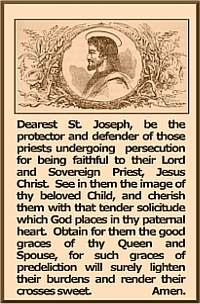 The last of the twelve constituent parts of the Mass (and which dates back to the 4th or 5th century) is the Postcommunion, a prayer mainly of petition in which the priest implores that all receive the fruits of the Sacrifice of the Mass. If any of the faithful do not partake of a sacramental Communion, they should make a spiritual one so that they, too, may greatly benefit from the prayers of the Postcommunion.
The last of the twelve constituent parts of the Mass (and which dates back to the 4th or 5th century) is the Postcommunion, a prayer mainly of petition in which the priest implores that all receive the fruits of the Sacrifice of the Mass. If any of the faithful do not partake of a sacramental Communion, they should make a spiritual one so that they, too, may greatly benefit from the prayers of the Postcommunion.
In this prayer, we also express our grateful sentiments to God for being so intimately present. We ask Him to abide with us as the darkness of evening approaches; to enable us to return His love; to grant us every grace necessary to persevere in the Faith against the assaults of the world, the flesh, and the devil.
We can imagine the joy of the apostles in being with our Lord for the 40 days before his Ascension! It was then that he explained many things to them. And in order to teach, govern and sanctify all of mankind, He gave them authority and power to preach, baptize, loose and bind. The deposit of Faith entrusted by Christ to the Apostles is the pearl of great price which we may be reasonably assured of preserving in its integrity by assisting at the ancient, Traditional Latin Mass. As astounding as this claim may sound, it is Gihr who very clearly explains why:
“The liturgy is, indeed, the main channel by which dogmatic tradition is transmitted; dogma is the root of all ecclesiastical life, of discipline and of worship. Worship is developed out of the doctrine of the faith; in the liturgical prayers, in the rites and ceremonies of the church, the truths of Catholic faith find their expression…the more fixed, unchangeable and inviolable the liturgical formula of prayer..the better…to preserve intact and to transmit unimpaired the original deposit of faith…[A]ll the primitive liturgies proclaim and prove that our faith is in perfect harmony with that of the first ages of the Church.”
Prayer: “Lord Jesus Christ, who didst vouchsafe after Thy resurrection to converse forty days with Thy disciples, and instruct them in all the mysteries of faith; teach me, I beseech Thee, to live according to Thy doctrine, and strengthen my faith that I may never doubt Thy Divine Revelation. Amen.”
_____________________
The N.O. dates back to April 3, 1969 when it was first promulgated by Paul VI, and, according to his friend Jean Guitton, to make it more compatible with Protestant theology: “The intention of Paul VI with regard to what is commonly called the Mass, was to reform the Catholic liturgy in such a way that it should almost coincide with the Protestant liturgy – but what is curious is that Paul VI did that to get as close as possible to the Protestant Lord’s supper… there was with Paul VI an ecumenical intention to remove, or at least to correct, or at least to relax, what was too Catholic, in the traditional sense, and, I repeat, to get the Catholic Mass closer to the Calvinist Mass.”



